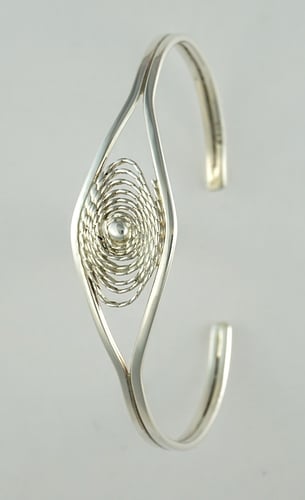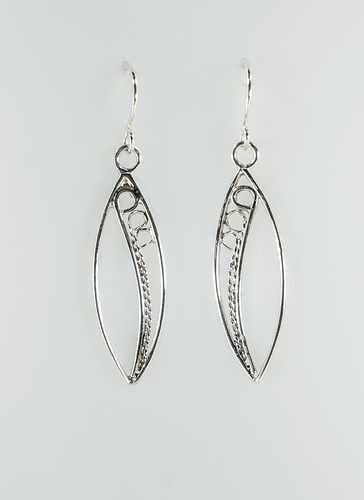I was watching a clip about filigree being done using very old and crude tools, but resulting in very nice work. When the separate elements were soldered together, the artists used some form of dense dark clay that could be formed in a shape that held the elements in a position that allowed them to be soldered together. The clay did not seem to interfere with the solder flowing, be harmed in any way by the flame and could be reuse. I imagine that the clay was some old recipe and doubt that this was any of the very expensive modern clay that I have seen in various catalogs. Does anyone have any idea what it is? Thanks…Rob
Rob,
I think I watched the same video recently. It certainly looks like clay. I found this paragraph in a Wiki search.
Methods of fabrication and usesEdit
The art may be said to consist in curling, twisting and plaiting fine pliable threads of metal, and uniting them at their points of contact with each other, and with the ground, by means of flux such as borax, by the help of the blowpipe. When granulated motifs are desired, small beads are made traditionally by using precious metal wire or fine sheet to start with, which is cut up in small pieces mixed with flux and placed in the small holes of a pitted block of charcoal (or any other suitable refractory material) and are then melted with a blowpipe (or today with a blowtorch), after which the bits of wire curl up and take a natural spherical like shape to end up in minuscule grains which slightly differ one from the other.[9][10] Small grains or beads of the same metals are often set in the eyes of volutes, on the junctions, or at intervals at which they will set off the wirework effectively. The more delicate work is generally protected by framework of stouter wire.
Brooches, crosses, earrings, buttons[11] and other personal ornaments of modern filigree are generally surrounded and subdivided by bands of square or flat metal, giving consistency to the filling up, which would not otherwise keep its proper shape.
Filigree jewelry design, and its twisting and soldering techniques, have an application in other metal-work such as wrought iron hanging wall brackets and silertoned doors.
Could it be charcoal, ground very fine and then compressed?
Brother Don.
I suspect that it is ground charcoal, but I don’t know what the flame safe binder is…Rob
Try Wolf Clay. Kate Wolf only sells directly to current & former students, but her website lists suppliers: Wolf Tools - WolfTools Not all of these vendors carry all of her products, though - for example, I do not believe Rio Grande is currently carrying this product. In addition to the companies Kate lists, it seems that Ronda Coryell sells it: https://www.rondacoryelldesigns.com/online-store/Tools-and-Supplies-c21508275
-Lorraine
I am not so much interested in buying it as I am in knowing what was in the stuff I saw in the video. I doubt that it was Wolf Clay. Thanks…Rob
Hi Rob,
Can you give a link to the clip…?
Janet in Jerusalem
My error. It took a while to find it, but the clay was used to position the pieces and hold them in place while what looks like investment was poured over them. Then, while held in place by the investment, they were soldered. Take a look at the following.
I have become fascinated by filigree and all the various forms it can take. I am especially fascinated by the crude tools used in some of the youtube videos that I have looked at, probably too many. Time to go to bed…Rob
This was my first guess but you said clay so I did a search and came up with this info of clay mixed with ash…https://www.cooksongold.com/forum/archive/index.php?t-6098.html
That description matches Rob’s video.
Unrelated to construction:
I clicked on “view full version”, then on photobucket slideshow at bottom of the first post.
Is the ninth photo showing a hidden weapon or is it just a handy swizzle stick?
A related question…Does anyone know where to get the heavy tweezers that I see being used in these filigree videos?..Rob
I made mine by taking a good pair of normal tweezers (solidly built–they don’t wiggle back and forth) and grind them down so that they have blunt, heavy tips. I also bought some heavier from a teacher who had them machined in Germany to her specifications, but I actually use the smaller ones I made myself more often, even when I’m not doing filigree. They are excellent for all kinds of small tasks because they let you leverage your hand strength more efficiently.
HTH,
Makena
Hi Rob, I have not tested my thoughts but I feel that it is “Green Sand” as used in sand casting and possibly mixed with something as the surface has a little more sheen than the standard green sand.
Do a Wikapedia search into it, you may be surprised.
I may try delft clay since I have some. It burns where it makes direct contacts with melted metal. I am not sure if this will interfere with solder flowing, but I won’t know until I try it. More when I know it…Rob
Love watching these videos… Sadly, the photobucket images of the step by step process have been removed  . But the text and video says it all!
. But the text and video says it all!
This is my first piece of filigree that I am willing to post. I had to modify my torch a bit to get a softer, less concentrated, flame. My goal is to first learn about traditional filigree and then see if I can work it into my style of cuff bracelets. After a lot of trial and error this week, I have figured out how to draw and roll fine wire and form it into traditional filigree shapes. I am challenged to find much on line, other than you tube videos, to help me learn more about filigree. If anyone has suggestions, please pass them on. Thanks…Rob
Hi Rob,
Search YouTube for a fellow named “Filigreenus”. His work is fantastic!
He demos making filigree wire and how to incorporate it in many designs. He also makes wonderful chains, and more.
Denny Diamond
Rob, if you are willing to pay for a resource go check out Victoria Russian Filigree DVD and eBook by Victoria Lansford, she has a video where she works thru several projects.
Thanks, I have looked at what I can of her work on line. I have learned a lot, but putting it to practice is still a challenge…Rob
Making progress and having fun with filigree. For someone who has forged and fabricated big heavy cuff bracelets for years, filigree is a big change. I don’t need a lot of tools, and my new optivisor helps a lot. I still need to tune my torch down a bit and do a lot of research and trial and error into what size stock renders what size frame and filigree elements…Rob
Lovely!
den

